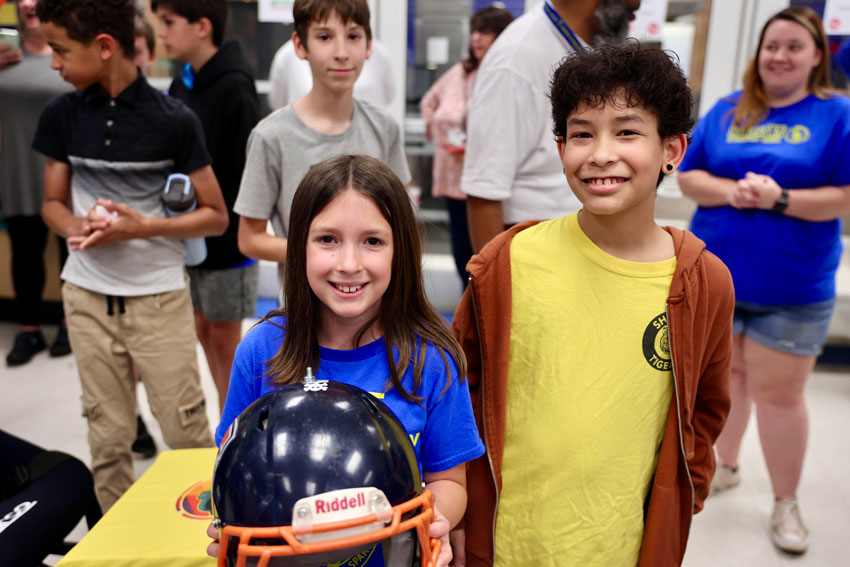
Recess is a favorite time of day for many students. But what about those with mobility challenges or physical disabilities? When Sandusky Elementary School students noticed their friend Norien, who’s in a wheelchair, wasn’t able to play on the monkey bars or join a game of kickball like they could, they were deeply concerned.
“It makes me feel sad that Norien can’t do everything we can do during recess. Kids need to be able to do fun stuff,” said Sandusky Elementary student Rachel.
They brought the issue to their gifted education resource teacher, Carrie Lewis, during a class discussion about accessibility this past fall. Together, they wondered: How could they make recess more fun for Norien and other students with disabilities? They researched specialized adaptive playground equipment, but the prices were prohibitive. Then, one student had an idea. They’d recently taken a trip to Universal Studios, where they’d experienced a virtual reality (VR) ride that made them feel like they were playing Qudditch at Hogwarts, all while sitting in a chair.
Could VR simulation provide an accessible recess experience for students with physical disabilities? Lewis’s students were determined to find out. Together, they formulated a plan.
They’d record first-person point-of-view videos of themselves playing on the Sandusky Elementary playground. The viewer could watch these videos through a VR headset while sitting in a chair that would tilt and move along with the video, like the experiences at Universal. That way, Norien could get a taste of what it’s like to play on the equipment without limitations.
And the best part? This would all be a surprise for Norien. The students vowed to keep their work a secret. The image of his face when he finally experienced their creation for the first time would serve as their motivation.
“The children had big dreams and big visions. They couldn’t wait for the moment Norien would sit in the seat and wear the goggles for the first time,” Lewis said. “And they started to ask, ‘how many other children could benefit from this in other places?’ This idea could meet a need that isn’t being met elsewhere, and it could benefit people all over the world. They wanted to serve an underserved population.”
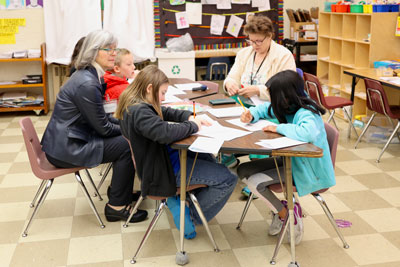
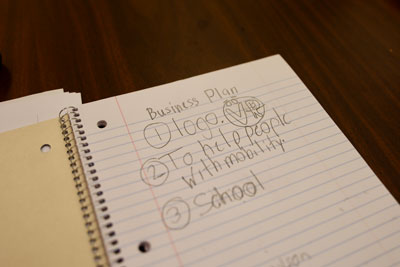
Developing Expanded Perspectives through Higher-level Thinking (DEPTH) students brainstorm how to bring their ideas to life.
Making the Vision a Reality
The equipment the students would need for this project wouldn’t be cheap. Lewis applied for a grant from the Lynchburg City Schools (LCS) Education Foundation, which provides thousands of dollars each year for teachers to bring their big ideas for educational projects to life.
“Their grant application was beyond anything we had seen before. It struck us that it was driven by the students, prompting them to think in a way they might not be used to. Their idea was truly innovative, and we immediately recognized its potential as a useful resource for students everywhere, not just at Sandusky Elementary,” said LCS Education Foundation director Dawn Wise.
The Economic Development Authority of the City of Lynchburg partnered with the nonprofit to sponsor the project, and Lewis’s application was approved. She knew a project of this magnitude would need more time and manpower than her once-a-week gifted class for third through fifth graders at Sandusky Elementary could provide. Lewis and her fellow Developing Expanded Perspectives through Higher-level Thinking (DEPTH) teacher Gaynell Phelps looped in their classes at Bedford Hills, Heritage, and Sheffield elementary schools, too.
Lewis worked with students at each school to research what kinds of equipment they’d need to make their vision a reality. They settled on a special chair with a harness, a 360-degree camera, and a VR headset. As their equipment trickled in, there was plenty of other work to be done. The students began crafting a brand identity for the project. Because if they were going to do this, they were going to make it professional.
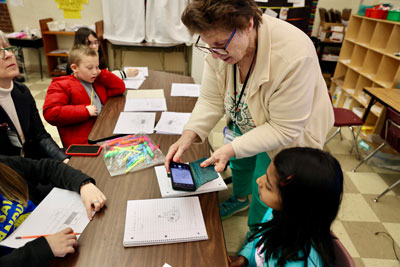
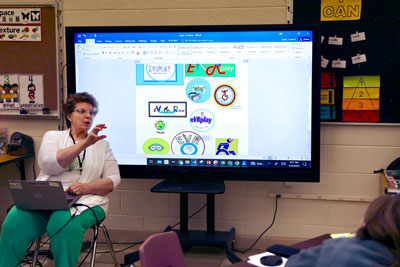
Left: Lewis photographs a student’s logo concept sketch. Right: Lewis leads the students in a vote for eVRplay’s official logo.
First, they needed a name for their project. Students brainstormed ideas and voted on a winner: “eVRplay.” They drew logos to match and digitized them in Canva. A colorful depiction of a VR headset secured the majority vote. The process was many students’ first foray into graphic design.
"My favorite part was making the logo because I got to be creative,” said Sandusky Elementary student Brianna.
eVRplay felt bigger than a school project. Conversations about bringing the initiative to other schools started coming up in conversation. If there was widespread demand for eVRplay, it could help make recess accessible for students in schools across the country. They could upload their playground videos to YouTube, and other schools could acquire their own headsets and chairs with which students could watch them.
“There’s nothing like this out there already. The children are meeting a need in a truly innovative way,” Lewis said.
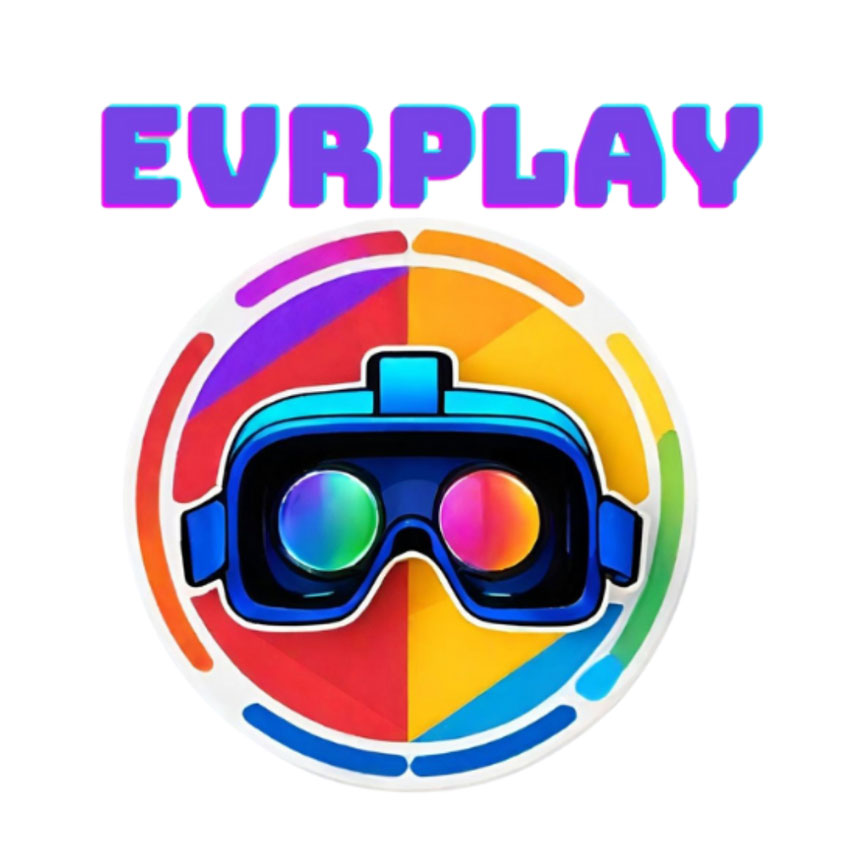
eVRplay’s official logo.
The students drew inspiration from young entrepreneurs, like Zollipops inventor Alina Morse, who set out to create a lollipop that doesn’t cause cavities at just seven years old. They studied famous inventors from the past, like Thomas Edison and Nikola Tesla.
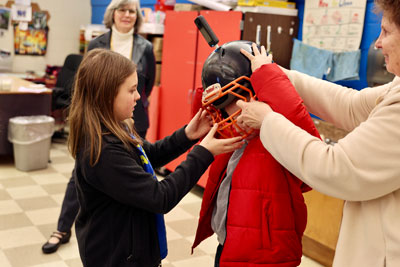
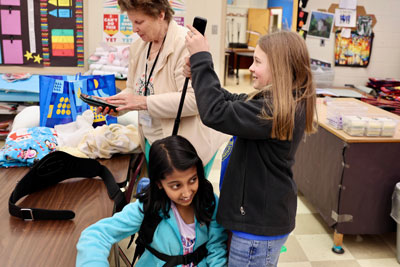
The students experimented with different ways to mount the 360-degree camera for recording.
As they started to receive the equipment they’d ordered, the technical experimentation phase of the project began. First, they set out to record videos on the 360-degree camera that could be watched using the VR headset.
“The students led this process. Not only did they come up with the branding and idea behind the project, but they also figured out how to use the equipment, filmed the videos, and edited them. My role was to open doors for them and follow them as they explored,” Lewis said.
The students tested various ways to mount the camera so as not to block its view or cause motion sickness: strapped to the chest, attached to a backpack, secured to a hat, and handheld on a selfie stick. Eventually, they settled on two workable solutions: a headband secured to a baseball cap and a football helmet with a bolt securing the camera on top, each rising just far enough above the head so as not to obstruct the shot.
With the logistics of recording worked out, the students moved on to filming first-person point-of-view shots of themselves playing at recess. It took some time to learn how to record videos in a way that would be engaging for viewers, but after recording and watching back several takes, the students had developed a technique. They recorded themselves on the monkey bars, the slide, the swingset, and playing games of kickball with other students. Then, they uploaded the footage into a 360-degree video editing software to cut and polish them.
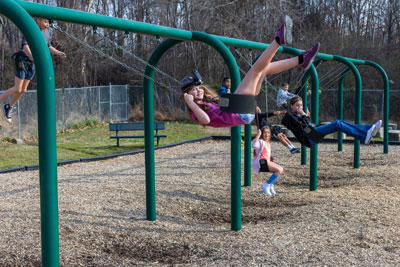
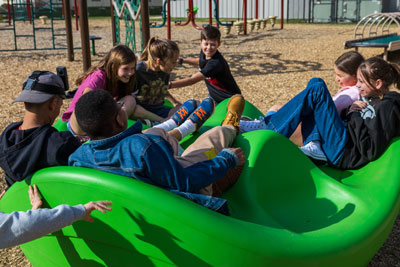
Students film various playground activities using the 360-degree camera.
“I really liked editing the videos. Ms. Lewis taught us how to stitch and export clips. It was hard,” Rachel said.
The last components to arrive were the chair and safety harness. They adapted the chair for Norien by adding a custom footrest and padding sharp edges with a pool noodle.
eVRplay became a collaboration between the four schools, each contributing their own unique ideas and perspectives during their weekly DEPTH class. Lewis and Phelps would synthesize their contributions and serve as the links binding the project together.
Pulling off a project of this magnitude was no easy task, not to mention coordinating students and hauling equipment between the schools. Neither Lewis, Phelps, nor their students had ever done anything like this before, and they were learning as they went.
“I was teaching myself along with them and modeling how to seek solutions and figure things out when things don’t work as expected. There was a lot of trial and error involved in this project, but we kept trying until we succeeded,” Lewis said.

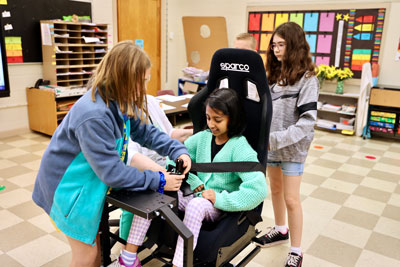
Students grappled with unexpected challenges, including modifying the chair to make it safe and comfortable for Norien, before eVRplay’s public debut.
The students formulated a plan to reveal their invention to Norien. They’d present their project at the LCS Education Foundation Classroom Innovation Grant reception in May and invite Norien. Lewis met with his parents, who agreed to bring him to the reception without revealing the surprise.
By the time they received the chair, the end of the school year was fast approaching. With limited time between the chair’s arrival and the grant reception, they hadn’t had a chance to program the chair to move in sync with the videos, but they were confident Norien would still be impressed by the VR video experience.
With eight months worth of work to present at the reception, preparing their presentation was a challenge. They programmed an AI chatbot to answer frequently-asked questions about eVRplay in order to make the information more digestible. With all the pieces in place, they eagerly awaited eVRplay’s debut.
The Big Reveal
On the night of the reception, grant recipients from all over the division congregated in the E. C. Glass High School cafeteria to present the projects they’d completed using funds from the LCS Education Foundation. Forty DEPTH students hovered around the eVRplay display. They came prepared with business cards displaying their logo and a QR code to connect users with their AI chatbot, various camera-mounting contraptions they’d crafted during the filming phase, and most importantly, the VR headset and chair. As teachers, administrators, families, and community members flowed through the room to learn about the projects on display, the DEPTH students anxiously awaited Norien’s arrival.
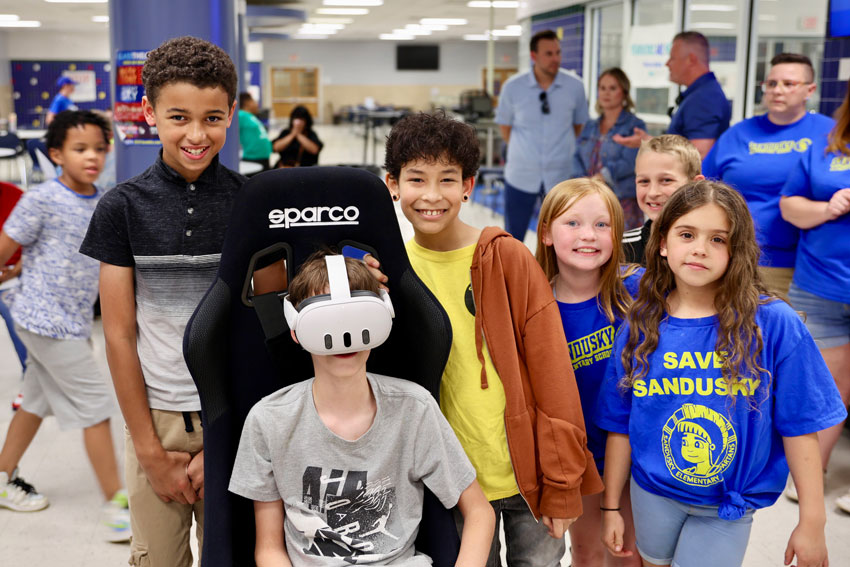
DEPTH students from all four participating elementary schools presented their work at the LCS Education Foundation Classroom Innovation Grant reception.
When Norien entered the room with his parents, the look of shock on his face was palpable. Smiling from ear to ear, his peers led him to the chair and helped him put on the headset. His surprise turned to ecstasy as the video played.
“I got scared for a second, but then I tried it out. I felt like I was flying when I watched the slide video,” said Norien, who’d never used a VR headset before. “The monkey bar video felt like I was swinging in the air. I’ve never been on the monkey bars. I thought I was at school when I watched it.”
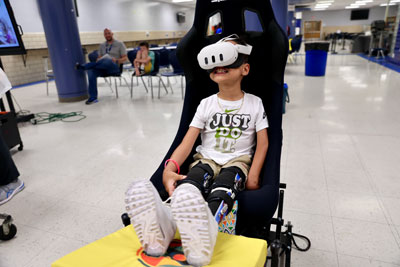
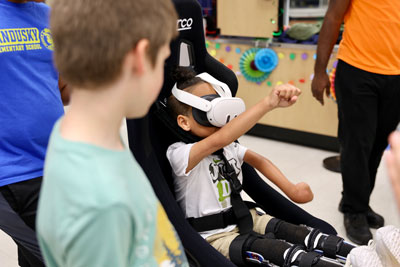
Norien was thrilled by his first VR experience.
Norien’s parents looked on, teary-eyed. His mom, Tess, had been keeping the project a secret ever since Lewis told her about it two weeks prior.
“I cried like a baby when I found out. I think it’s beautiful that these kids from different schools pulled together and made this for him. It’s so special. I can’t grasp it. It really touches my heart,” Tess said. “Him being able to experience this is crazy. We can help him play on some of the equipment, but we’re limited in what we can do because we have to physically hold him up. This is really big for him.”
Norien laughed, shouted, and waved his arms, immersed in the world his friends had captured for him. His peers could hardly contain their excitement as they watched him.
“With him being different, kids can be mean. He can be singled out. But these kids make him feel so special and loved, and he loves everyone back. I couldn’t be more thankful for the staff and students,” Tess said.
The DEPTH students cite uplifting Norien and other kids with physical disabilities as the main motivating factor behind their work. Not only did they learn valuable skills and work their problem-solving muscles, but they also helped a friend feel the same joy they do at recess.
“I’m very happy and grateful to be a part of this. I’m excited for all the people who might be able to experience stuff they’ve never experienced for the first time,” said Sheffield Elementary student Camden.
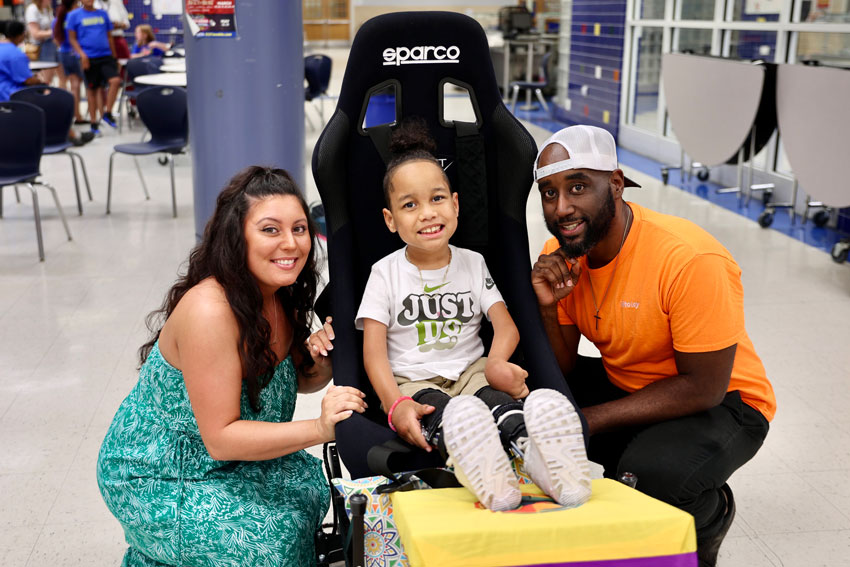
Norien with his parents.
Learning by Leading
The gravity of what they’d accomplished wasn’t lost on the DEPTH students. Their confidence had steadily grown over the course of this project, and many had unlocked unexpected new passions, from video editing to engineering. News of the project spread, and to the students’ great excitement, some were even interviewed on WLNI’s morning radio show.
“Their self-esteem is through the roof. These children believe they can do anything, especially after this experience. They’ve weathered some seemingly insurmountable obstacles along the way, but they’ve done it with a great attitude and never gave up,” Lewis said.
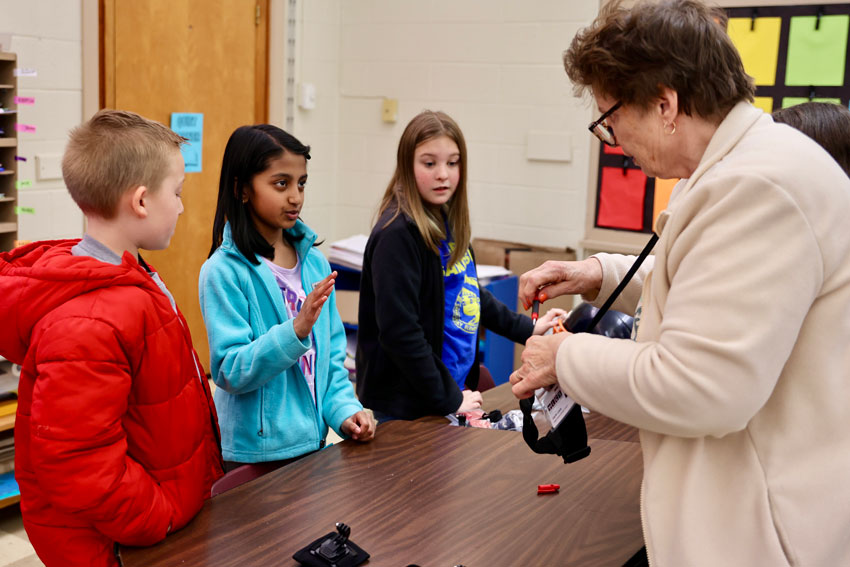
Working on eVRplay empowered students to exercise their leadership and problem-solving skills.
The DEPTH program provides LCS third through fifth graders who meet gifted eligibility requirements with at least 45 minutes of problem-solving, critical or creative thinking, and inquiry-based learning opportunities in small-group settings each week. eVRplay provided a perfect opportunity for them to take ownership of their learning and solve complex problems.
“I think what they’ve done is so impressive. When my daughter comes home and talks about what she’s doing in DEPTH, it sounds so advanced. It’s over my head,” said Sandusky Elementary parent Christie Frye. “Mrs. Lewis encourages these kids to be creative and solve problems. She’s amazing.”
Though eVRplay has made its public debut, the work isn’t over. This summer, select students are working with CloudFit software engineering interns and staff members to automate the chair to move in sync with the 360-degree videos. Once the school year starts again, they’ll continue adding to their library of videos on YouTube. They hope eVRplay can be a resource for other disabled students in the future.
“These students are our future leaders. Projects like this are why I teach. I love seeing them grow, and their desire to help Norien and other disabled students is inspiring,” Lewis said.
